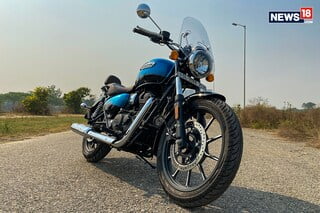
Royal Enfield pretty much showed the world that they can make motorcycles that everyone has to stand up and take notice of. The motorcycles that gave them this reputation are the Interceptor 650 and the Continental GT 650 and the reason for their success is that both of these motorcycles were leaps and bounds ahead of any other motorcycle that Royal Enfield has ever made. Now, however, they have taken all of those learnings and approach and brought it down to the 350cc segment.
Interestingly, though, it is not the Classic 350 that debuts this new-found approach, but it’s a motorcycle that replaces the Thunderbird series of offerings from Royal Enfield. It is as the Meteor 350 and after spending about five days riding this motorcycle through city and highway and here’s what I have to say about it.
Let’s begin our understanding of the motorcycle by first talking about the design. At first glance, the Meteor 350 might look similar to the Thunderbird X series of motorcycles that Royal Enfield came out with, once you see it in flesh, you realise that’s really not the case. That’s because Royal Enfield says that they have not carried over any part from the Thunderbird to the Meteor 350.
There are three variants on offer. The entry-level variant is called Fireball, the one that sits on top of it is called Stellar and the top-most variant is called Supernova – that variant that we rode. It gets extra chrome bits, the backrest, the fancy wind-deflector, alloy wheels – you get the idea, this is supposed to give you that big cruiser feel.
Now, looks are a subjective matter so I’ll let you decide how you find this motorcycle but there are some key design elements that I want to bring to your notice.
First and foremost, Royal Enfield has upped the standards of the build quality and the quality of materials used. The paint finish on this Supernova variant is great and it makes the bike feel premium.
Royal Enfield has taken some interesting design choices too. Like, the fuel tank cap has no visible hinge or a key slot when the lid is closed and that looks really nice. You also get these really old-school toggle switches for ignition and the headlamp controls which take some time getting used to but retain their novelty factor.
You also get a USB port under the left switch cluster which sounds nice but is actually an ergonomic nightmare as getting the wire to plug into the port takes a lot of effort due to lack of space and only works when the engine is turned on. You can pretty much forget about getting that done with gloves on. I would have much rather had an under-seat USB port as that would eliminate the need of having a phone mount on the handlebar completely.
Coming to the instrument cluster, the one on the left is a semi-digital unit that shows pretty basic information like your odometer, two trip meters, a clock and the gear position indicator. I did miss having a range indicator because well, the Meteor is built for long-distance riding and for that knowing your distance to empty is really important.
[“source=hindi.news18”]






